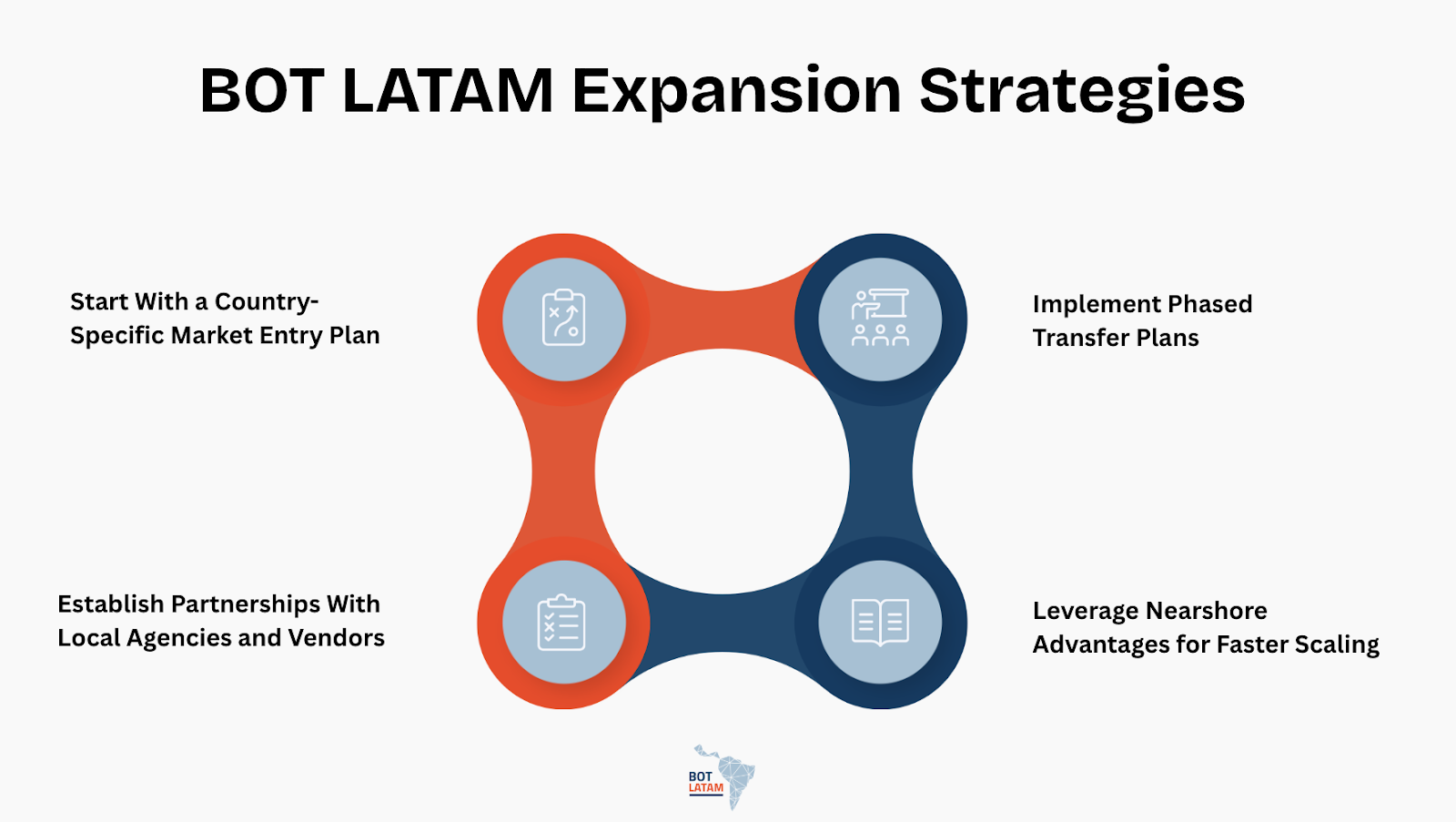Expanding into Latin America is no longer a niche strategy. The region has become one of the fastest-growing destinations for global business, with foreign direct investment in LATAM reaching over $224 billion in 2022, according to UNCTAD. Companies looking to scale without unnecessary risk are increasingly turning to the Build Operate Transfer (BOT) model as a practical path forward.
In this article, you’ll explore how BOT works in Latin America, what successful solutions look like in practice, and why the model is gaining traction across industries. You’ll see how BOT can help you manage compliance, reduce costs, and access a highly skilled workforce. You’ll also get a market guide highlighting key opportunities, country breakdowns, and the latest trends driving BOT expansion in the region.
From step-by-step strategies to insights on technology, innovation, and long-term sustainability, this guide gives you a clear picture of how BOT can strengthen your footprint in Latin America. Whether you’re planning your first move into the market or looking to optimize existing operations, this article will provide the practical knowledge needed to evaluate if BOT is the right model for your growth.
Understanding the LATAM Market for BOT Expansion
Why LATAM is an Attractive Region for BOT Projects.
Latin America has positioned itself as a top nearshore alternative for global companies. The region’s IT and business services market is projected to exceed $35 billion by 2027, according to IDC, making it one of the fastest-growing outsourcing destinations. BOT expansion works especially well here because of strong urban tech hubs, favorable trade agreements, and a workforce with rising digital skills.
Beyond cost efficiency, LATAM offers time zone alignment with North America. This reduces delays in communication and project delivery, giving companies a smoother transition compared to offshore models in Asia or Eastern Europe.
Country-Specific Opportunities: Brazil, Mexico, Colombia, and Chile.
Not all LATAM markets are equal when it comes to BOT adoption. Brazil is the largest tech market in the region, representing 40% of all IT spending in LATAM, according to IDC. It’s a prime location if you want scale and advanced infrastructure.
Mexico benefits from geographic proximity to the U.S. and the USMCA trade agreement, which makes cross-border business operations simpler. Colombia has built a strong reputation for BPO and fintech services, with Bogotá and Medellín becoming tech hubs. Meanwhile, Chile offers political stability and one of the region’s highest digital adoption rates, making it ideal for BOT setups with a long-term view.
Comparing LATAM to Asia and Eastern Europe for BOT Services.
Asia remains a popular outsourcing destination, but LATAM holds an edge for companies prioritizing collaboration and speed. While countries like India and the Philippines offer larger labor pools, the cultural and time zone alignment of LATAM markets creates fewer operational barriers.
Eastern Europe is competitive for highly specialized IT skills, yet LATAM often provides more favorable tax incentives and trade partnerships for U.S.-based firms. The BOT model thrives in LATAM because it combines workforce quality with regional accessibility, something many businesses rank as more valuable than cost savings alone.
Key Economic and Political Trends Impacting BOT Expansion.
LATAM’s market is not without risks, and understanding them is essential before launching a BOT operation. Inflation and regulatory changes can impact costs, though many countries are taking steps to stabilize their economies. For example, Chile and Mexico rank among the top 50 countries in the World Bank’s Ease of Doing Business Index, signaling regulatory improvements.
At the same time, regional governments are investing heavily in digital transformation. Over 70% of Latin American companies plan to increase spending on cloud and digital services through 2025, according to Statista. This creates a stronger environment for BOT projects, especially in industries like fintech, logistics, and healthcare, where modernization is moving quickly.
BOT Model Success Solutions To Apply In LATAM
1. Align BOT Setup With Local Legal Frameworks:
Each Latin American country has different regulations around labor, taxation, and data handling. Structuring your BOT model around these frameworks prevents compliance risks that can derail expansion. For example, Mexico’s labor reform of 2021 restricted subcontracting practices, which directly affects BOT agreements. Staying ahead of such policies ensures smoother transitions from the operate stage to the transfer stage.
2. Establish Clear Governance Structures Early:
Without strong governance, BOT projects in LATAM risk delays and cost overruns. Defining roles, escalation paths, and reporting processes from the start keeps both the local BOT partner and your internal teams aligned. Research by PwC shows that projects with strong governance are 30% more likely to be delivered on time and within budget.
3. Prioritize Talent Development and Retention:
While LATAM offers a large pool of skilled professionals, turnover can be a challenge. You can strengthen BOT outcomes by investing in employee training, offering competitive benefits, and creating career growth pathways. According to Deloitte’s 2023 LATAM Human Capital Trends report, 72% of companies in the region see reskilling as critical to business resilience. Integrating this into the BOT model reduces disruptions when operations are eventually transferred.
4. Integrate Local Expertise Into Operations:
BOT works best in LATAM when local knowledge is embedded into daily operations. This includes hiring managers familiar with regional business culture, understanding local consumer behavior, and building supplier relationships. For example, Brazil’s business environment places high importance on personal trust and relationship-building, which can significantly impact supplier negotiations and contracts.
5. Build Scalable Digital Infrastructure:
Technology is a core success factor for BOT in LATAM. Cloud adoption in the region grew over 30% year-on-year in 2023, showing that businesses are rapidly digitizing. By implementing scalable IT infrastructure and automation early in the BOT cycle, you create a foundation that can expand seamlessly once operations are transferred.
6. Measure and Benchmark Performance Regularly:
A BOT model without consistent measurement can easily lose momentum. Establishing KPIs around delivery times, cost savings, employee satisfaction, and compliance allows you to track whether the BOT setup is meeting expectations. McKinsey research shows that companies that regularly benchmark performance are 45% more likely to achieve above-average profitability. For LATAM, this ensures adjustments can be made quickly in a changing market environment.
The Key BOT LATAM Expansion Strategies

Start With a Country-Specific Market Entry Plan:
Not every LATAM country offers the same advantages for BOT setups. Mexico is favored for proximity to the U.S. and trade benefits under USMCA, while Brazil accounts for 40% of IT spending in the region. Colombia and Chile stand out for their stability and growing digital economies. Designing an entry plan that matches your industry with the right country reduces risks and accelerates results.
Establish Partnerships With Local Agencies and Vendors:
Local expertise is critical for smoother BOT expansion. Partnering with agencies that understand labor regulations, supply chain networks, and cultural practices speeds up operations. In Colombia, for example, local partnerships are often a prerequisite for entering government or fintech projects, which are among the fastest-growing BOT opportunities in the region.
Implement Phased Transfer Plans:
A successful BOT expansion doesn’t move operations all at once. Transferring processes in stages allows your internal teams to adapt while minimizing operational risks. Companies that use phased transfer models report 20–30% fewer disruptions compared to single transfer strategies, according to the Deloitte Global Outsourcing Survey. In LATAM, this approach is particularly effective in markets where regulations or workforce structures are still evolving.
Leverage Nearshore Advantages for Faster Scaling:
One of LATAM’s strongest selling points is its nearshore position relative to North America. Time zone overlap enables real-time collaboration, which is especially important during the “operate” phase of BOT. Studies show that nearshore teams in LATAM reduce communication delays by up to 40% compared to offshore locations, according to the Everest Group. Building strategies that capitalize on this advantage ensures smoother scaling once operations are handed over.
Future Outlook of BOT in LATAM
1. Rising Demand Driven by Nearshoring Trends:
The global shift toward nearshoring is reshaping how companies expand. According to Kearney’s 2023 Reshoring Index, 40% of U.S. companies are exploring nearshore options in Latin America to reduce supply chain risks. This shift will directly fuel BOT adoption, as businesses look for models that balance local control with global scalability.
2. Industry Sectors Expected To Lead BOT Growth:
Sectors like fintech, logistics, and healthcare are primed for BOT expansion. LATAM’s fintech market alone grew 112% between 2018 and 2022, according to the Inter-American Development Bank, making it one of the fastest-growing in the world. These industries require both compliance and digital innovation, areas where BOT models can deliver long-term stability and operational efficiency.
3. Increased Government Support for Digital Infrastructure:
Governments across LATAM are prioritizing digital transformation. Brazil’s Ministry of Communications reported that 92% of municipalities were connected to 4G networks by 2023, improving infrastructure for technology-driven BOT projects. Mexico and Chile are also investing heavily in cloud adoption and cybersecurity, reducing barriers for companies planning long-term BOT operations.
4. Workforce Evolution and Talent Availability:
The talent pool in Latin America is expanding rapidly. The World Bank projects that by 2030, more than 1.2 million new tech professionals will enter the workforce in the region. However, demand will still outpace supply, which means BOT models that emphasize early recruitment and training pipelines will remain the most competitive.
5. Long-Term Sustainability of the BOT Model:
BOT in LATAM is moving from a niche outsourcing strategy to a mainstream expansion model. Deloitte’s Global Outsourcing Survey highlights that companies using BOT see operational efficiency improvements of 20–25% compared to traditional outsourcing. As more firms prioritize governance, digital adoption, and regional integration, BOT will likely become a standard pathway for businesses entering Latin American markets.
Ready to Use BOT as a Bridge to LATAM Market Success?
Latin America is no longer an experimental market for global expansion. With nearshoring on the rise, BOT models are proving to be one of the most reliable frameworks for long-term growth. Companies that prioritize governance, talent development, and phased transfer strategies are consistently seeing higher efficiency gains compared to traditional outsourcing.
At BOT LATAM, we specialize in guiding businesses through this transition. Our expertise lies in aligning BOT operations with local regulations, building scalable teams, and ensuring a seamless transfer process. By combining regional insight with proven execution models, we help organizations reduce risk while capturing the full advantages of BOT expansion in Latin America. If you are ready to start your expansion. contact us!

Revolutionize Your Workflow with Our Innovative BOT Strategy!
Enhance your operations seamlessly and adapt to market demands
Contact Us



%2017.26.38.png)
